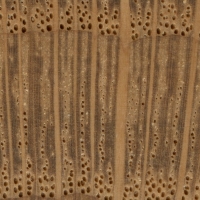Brown Oak is technically not a distinct species of oak, but rather refers to oak (almost always English Oak or another European species) that has been infected with a fungus. This fungus (Fistulina hepatica) has the effect of turning the wood a deep brown color. Once the wood has been cut and dried, the fungus dies, leaving a rich golden brown lumber.
Brown Oak is obviously not as common as regular oak, and the demand seems to be elevated, so prices are likely to be high for what could be considered a “domestic” hardwood for those in Europe—with prices going even higher for imported Brown Oak in the United States. Nonetheless, many people are willing to pay a premium for the rich, aged-look of Brown Oak.
A special thanks to Steve Earis for providing the wood sample, veneer, and turned photo of this wood species.
 |
 |
 |
 |
 |
- Black Oak (Quercus velutina)
- Bog Oak
- Bur Oak (Quercus macrocarpa)
- California Black Oak (Quercus kelloggii)
- Cherrybark Oak (Quercus pagoda)
- Chestnut Oak (Quercus prinus)
- English Oak (Quercus robur)
- Holm Oak (Quercus ilex)
- Japanese Oak (Quercus mongolica)
- Laurel Oak (Quercus laurifolia)
- Live Oak (Quercus virginiana)
- Oregon White Oak (Quercus garryana)
- Overcup Oak (Quercus lyrata)
- Pin Oak (Quercus palustris)
- Post Oak (Quercus stellata)
- Red Oak (Quercus rubra)
- Scarlet Oak (Quercus coccinea)
- Sessile Oak (Quercus petraea)
- Shumard Oak (Quercus shumardii)
- Southern Red Oak (Quercus falcata)
- Swamp Chestnut Oak (Quercus michauxii)
- Swamp White Oak (Quercus bicolor)
- Turkey Oak (Quercus cerris)
- Water Oak (Quercus nigra)
- White Oak (Quercus alba)
- Willow Oak (Quercus phellos)





We’ve been asked to manufacture some external joinery – windows and doors – for a client using his own brown oak. Could anyone advise suitability please?
there are two main forms of brown rot in oaks, and at least two other forms one very rare the other localy common. Fistulina hepatica is the desired one, the one foresters know to be the true brown oak, as fistulina hepatica feeds mainly off the acids or more specificaly vinegars and actualy alters the wood very little till very advanced decay. Laetiporus suphureus is the more difficult to work version of brown oak, more stripey in colour and tends to cause a lot of medullary splitting on drying as the fungus uses this pathway for colonisation strategies. the turned… Read more »